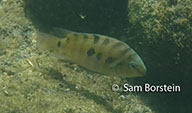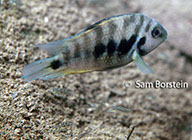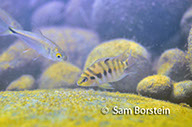Archocentrus siquia
(Schmitter-Soto, 2007)
Synonyms: Amatitlania siquia, Cryptoheros siquia

Above: A wild pair of Archocentrus siquia "Rio Cabuyo, Costa Rica". Female in foreground male in background. Photo by Sam Borstein.
Etymology:
Genus- Arch= anus (Greek), kentron= sting (Greek), Referring to the anal fin spines.
Species- siquia= avocado (Miskito), the specific name refers to the river the type specimen was collected in.
Intro:
Archocentrus siquia is a wonderful Convict type cichlid that is relatively new to the hobby. This is convict species has the widest distribution spanning Honduras through Costa Rica. There tends to be lots of variation through this range in both male and female coloring. Males can range from a base color of blue, reddish, to solid yellow like the male above. The ventral blotch of the females can vary from orange red, orange, yellow, and even bright gold.
There has been much debate about this fish and where it stands taxonomically speaking. Allgayer in 2001 created the genera Cryptoheros, with the type being Archocentrus spilurus. This description was poorly done. Schmitter-Soto published a paper that came out in 2007, Convicts were given their own genera, Amatitlania, composed of the four species and one undescribed species. Off the bat the genus Amatitlania was rejected by many scientists. Although there may be more than one species of Convict, the descriptions for the three new species are poorly done and in doubt. Because of this I leave this fish in Archocentrus until a proper review of the Convict Cichlid and its allies is completed.
The four species described in Schmitter-Soto's paper are:
- A. coatepeque- Restricted to Lake Coatepeque, El Salvador.
- A. kanna- Ranging from the very Southeast of Costa Rica to Panama.
- A. nigrofasciata- Ranging from Southern Guatemala to Northern Honduras.
- A. siquia- Ranging from Honduras to Costa Rica.
Although I highly doubt these represent valid species and believe that the Convict Cichlids are just one diverse species, many hobbyists have taken to these names and use them at present. Because of this you will see them on my site as different species. This may be a good thing as Convict Cichlids are quite diverse in coloration throughout their large range and because they may or may not represent different species they are different enough that one should never keep more than one location of convict in their aquarium for fear of hybridization. These new names are nice as hobbyists have been paying much more attention to where these fish are from and some new location variants of this species have since made it to the hobby.
Distribution:
As stated above, Archocentrus siquia has a very large distribution. It starts in southern Honduras and stretches to southern Costa Rica. This fish inhabits large rivers and creeks of variable flow as well as lakes. This includes the Great Lakes of Nicaragua.
Below you can see the variability in color this species has by looking at the fish from different locations. Click on a thumbnail for a full size photo. All photos by Sam Borstein.
Size, Maturity, and Sexual Dimorphism:
Size: Males- 7 inches, Females- 4 inches
Maturity: 1.5 inches
Sexual Dimorphism: Males are larger and may have longer fins. Males also have a more rounded cranial profile. Females have a colorful belly, but some males may get a fair amount of coloration as well, so it can't always be used to sex the fish, but is usually a fairly good characteristic.


Above: Wild female (left) and male (right) Archocentrus siquia "Rio Cabuyo". Females have a colored belly ranging that differs in color between variants. Although this male is an exception and has a rather colored belly, Males can almost always be differentiated from females by a nuchal hump. Photos by Sam Borstein.
Care:
Archocentrus siquia poses little problem for the aquarist. Care should be exactly the same as for the common Convict Cichlid. Some location varieties do need slightly different care. In general, Archocentrus siquia is fairly well behaved outside of breeding. I've found this species to form very intense pair bonds. When spawning, Archocentrus siquia will become intolerant of any fish and actively protect their nest. Although they can be bred in a community tank, it will need to be large enough for the other fish to get away. This should be at least a 4 foot tank. In my experience this fish forms well bonded pairs that can be bred in smaller tanks. I've successfully kept various pairs of this species in a 20 gallon long and have had lots of luck breeding them without any aggression between the pair, although the bigger the tank the better.
Some Archocentrus siquia from the Nicoya Peninsula, Costa Rica are much larger than many of the other localities of Archocentrus siquia. It's not uncommon for males from the rivers of the Nicoya Peninsula to reach 6 inches and females typically reach 4. These tend to be messier fish and create much more of a bio load. It is highly recommended that a large tank no smaller than a 40 breeder be used to keep large pairs. In community set ups, a six foot tank is recommended as these species pack much more of a punch due to their size.
Diet:
Archocentrus siquia is omnivorous and will eat any prepared food. In the wild they feed opportunistically. Any aquarium flake or pellet will work well as will occasional feedings of frozen brine shrimp and blood worms..
Breeding:
Archocentrus siquia is quite easy to breed. This species forms fantastic pair bonds. As with most cichlids, the female will become plumper and fill with eggs prior to spawning. Female coloration also increases dramatically as the fish court and begin spawning rituals
Archocentrus siquia is a cave spawner like most Archocentrus. During spawning and continuing into brood care the fish become drab. Spawns range anywhere from 150-500 eggs. This is mostly dependent on the age and size of the female. The eggs hatch in about four days post spawn and by 10 days are free swimming. The fry grow quickly and are easy to raise on baby brine shrimp or crushed flake.
Parental behavior in this fish is amazing. Many of my wild pairs from the Rio Cabuyo, Nicoya Peninsula, Costa Rica have defended fry for three months! By this time they are 1.25"-1.5" in length.
The fry grow relatively fast like most Convict types and will start showing strong bars and orange coloration at about 3 months of age.

Above: A female Archocentrus siquia from the Rio Cabuyo guarding fry. Photo by Sam Borstein.
Conclusion:
Archocentrus siquia is a very nice and rather new fish. Many location variants of this fish are available with each one being slightly different. It's worth keeping different location variants to see the differences in coloration as well as slight behavioral differences. If you are a Convict Cichlid lover, you should try keeping this species as well as the location variants. Although not available from pet shops it is occasionally seen for sale from members of Cichlid clubs. Usually, this is a very inexpensive species to purchase. I really think all the Convict types are great fish as far as demonstrating the fantastic breeding behavior of cichlids and one that any die hard cichlid fanatic should keep and breed in their lifetime.
References:
- Allgayer, R. (2001) Description d'un genre nouveau, Cryptoheros, d'Amérique Centrale et d'une espèce nouvelle du Panama (Pisces: Cichlidae). L'An Cichlidé, 1, 13–20.
- Schmitter-Soto, J.J. (2007) A Systematic Revision of the Genus Archocentrus (Perciformes:Cichlidae), with the Description of Two New Genera and Six New Species. Zootaxa 1603, 1-76.






